SoftBank Group
SoftBank Group Corp.[7][8] is a Japanese multinational conglomerate holding company headquartered in Tokyo. SoftBank owns stakes in many technology, energy, and financial companies. It also runs Vision Fund, the world's largest technology-focused venture capital fund, with over $100 billion in capital.[9][10]
 Tokyo Shiodome Building, SoftBank's global headquarters in Tokyo | |
Native name | ソフトバンクグループ株式会社 |
|---|---|
Romanized name | SofutoBanku Gurūpu Kabushiki gaisha |
| Public KK | |
| Traded as | TYO: 9984 TOPIX Core30 component |
| ISIN | JP3436100006 |
| Industry | Conglomerate |
| Founded | 3 September 1981 |
| Founder | Masayoshi Son |
| Headquarters | Tokyo Shiodome Building, , |
Key people | Masayoshi Son (founder and CEO) Ronald D. Fisher (vice chairman) |
| Products |
|
| Revenue | ¥9.60 trillion (2019)[1] |
| ¥2.38 trillion (2019)[1] | |
| ¥1.45 trillion (2019)[1] | |
| Total assets | ¥31.18 trillion (2018)[2] |
| Total equity | ¥6.27 trillion (2018)[2] |
| Owner |
|
Number of employees | 74,952 (2018)[4] |
| Subsidiaries |
|
| Website | global |
The company is known for its leadership by founder Masayoshi Son.[11] It operates in broadband, fixed-line telecommunications, e-commerce, internet, technology services, finance, media and marketing, semiconductor design, and other areas.
SoftBank was ranked in the Forbes Global 2000 list as the 36th largest public company in the world,[12] and the second largest publicly traded company in Japan after Toyota.[13]
The logo of SoftBank is based on the flag of the Kaientai, a naval trading company that was founded in 1865, near the end of the Tokugawa shogunate, by Sakamoto Ryōma.[14]
Although SoftBank does not affiliate itself to any traditional keiretsu, it has close ties with Mizuho Financial Group, its main lender.[15]
History
Founding and early years
SoftBank was founded in September 1981 as a SOFTBANK Corp. by then-24-year-old Masayoshi Son, originally as a software distributor. They went into the publishing business in May 1982 with the launches of the Oh! PC and Oh! MZ magazines, about NEC and Sharp computers respectively.[16] Oh!PC had a circulation of 140,000 copies by 1989.[17] It would go on to become Japan's largest publisher of computer and technology magazines and of trade shows.
In 1994, the company went public and was valued at $3 billion.[17] In September 1995, SoftBank agreed to purchase US-based Ziff Davis publishing for $2.1 billion.[18]
1995–2009 expansion
SoftBank bought COMDEX from The Interface Group on 1 April 1995 for $800 million, and ZDI on 29 February 1996.[19][20] SoftBank sold COMDEX to Key3Media, a spin-off of Ziff Davis, in 2001.[21]
In the nineties, Son made large forays into Internet services. In 1996, SoftBank made a joint venture with rising American internet company Yahoo!, creating Yahoo! Japan, which would go on to become a dominant site in the country.[22]
In October 1999, SoftBank became a holding company.[23] In 2000, SoftBank made its most successful investment ever – $20 million to a then-fledgling Chinese Internet venture called Alibaba.[24] This investment turned into $60 billion when Alibaba went public in September 2014.[25][26]
On 28 January 2005, SoftBank became the owner of the Fukuoka SoftBank Hawks, a Nippon Professional Baseball team. On 17 March 2006, SoftBank announced its agreement to buy Vodafone Japan, giving it a stake in Japan's $78 billion mobile market. In April 2006, they bought a 23% stake of Betfair, an Internet betting exchange. In August 2006, SoftBank sold all its shares of SBI Group to a subsidiary of SBI's holding company, making SBI independent. On 1 October 2006, Vodafone Japan changed its corporate name, mobile phone brand name, and its mobile phone domain name to SoftBank Mobile, SoftBank, and [mb.softbank.jp], respectively.[27]
On 28 January 2008, it was announced that SoftBank and Tiffany & Co. collaborated in making a limited 10 model-only cellphone. This cellphone contains more than 400 platinum diamonds, totalling more than 20 carats. The cost is said to be more than 100,000,000 yen.[28]
2010–2016 acquisitions
On 3 February 2010, SoftBank acquired 13.7% in Ustream with the option to increase shares to 30% by July 2011.[29] On 1 October 2010, Ayumi Hamasaki became the commercial spokesperson.[30]
On 3 October 2012, the takeover of competitor eAccess was announced and was completed in January 2013.[31] On 1 July 2013, SoftBank announced that Willcom became a wholly owned subsidiary effective 1 July 2013, after termination of rehabilitation proceedings. eAccess was merged with Willcom, which resulted in a new subsidiary and brand from Yahoo! Japan, Ymobile Corporation.
On 15 October 2012, SoftBank announced plans to take control of American Sprint Nextel by purchasing a 70% stake for $20 billion.[32] On 6 July 2013, the United States Federal Communications Commission approved SoftBank's acquisition of the Sprint Corporation for $22.2 billion for a 78% ownership interest in Sprint. The acquisition involved a payment of $17.2 billion in cash to Sprint shareholders, with the balance $5 billion as a capital contribution. The transaction was financed by way of cash and a bridge loan from a consortium of banks.[33] On 6 August 2013, SoftBank bought 2% more shares of Sprint Corporation, increasing its ownership stake in the company to 80%.
In October 2013, SoftBank acquired 51% stake in Supercell for a reported $2.1 billion. Later on 25 October 2014, they invested $210 million in OlaCabs,[34] $627 million in Snapdeal with 30% stake in the company on 28 October 2014, and a $100 million investment in Housing.com with 30% stake in the company in November 2014.[35]
In 2013, the company bought a controlling stake in French company Aldebaran Robotics, which was rebranded SoftBank Robotics. In 2014, teams from both companies co-designed Pepper, a humanoid robot. In 2015, SoftBank increased its stake to 95% of Aldebaran Robotics.[36][37]
In 2015, SoftBank acquired DramaFever.[38] In May 2015, Masayoshi Son said he would appoint Nikesh Arora, a former Google executive, as Representative Director and President of SoftBank. Arora has been heading SoftBank's investment arm.[39] On 1 June 2015, SoftBank acquired additional 22.7% stake in Supercell, increasing its total stake to 73.2% and becoming the sole external shareholder of the company. In June 2015, SoftBank announced it would invest US$1 billion in the Korean e-commerce website Coupang as part of its overseas expansion plans.[40]
In July 2015, SoftBank announced the renaming of the company from SoftBank Corp. to SoftBank Group Corp. Meanwhile, SoftBank Mobile was renamed to SoftBank Corp., the now-former name of the company as a whole.[41] On 16 February 2016, SoftBank announced they would repurchase a record 14.2% of shares, valued at $4.4bn, in order to boost investor confidence.[42] On 31 March 2016, they announced they would sell shares worth $7.9 billion of their stake in Alibaba Group. On 21 June 2016, SoftBank sold its 84% stake in Supercell for reported US$7.3 billion to Tencent.[43] On 3 June 2016, Softbank agreed to sell most of its stake in GungHo Online Entertainment (approximately 23.47%) for about $685 million, which would thus end Softbank's majority ownership of the company, resulting in Gungho no longer being an associate of Softbank.[44][45][46] The offer was accepted by Gungho and completed by 22 June, thus allowing Gungho to become an independent company.[47][48]
In June 2016, Nikesh Arora stepped down as president of SoftBank amidst pressure from investors. Board member Ron Fisher and Baer Capital Partners founder Alok Sama stepped in to manage Arora's overseas investment duties.[49] Just a month later,[50] Son announced the company's largest deal ever to buy British chip designer ARM Holdings for more than US$32 billion.[51][52] This acquisition was completed on 5 September 2016.[53]
On 6 December 2016, after meeting with US President-elect Donald Trump, chief executive Masayoshi Son announced SoftBank will be investing US$50 billion in the United States toward businesses creating 50,000 new US jobs.[54][55][56]
2017–2018
On 30 January 2017, the Wall Street Journal wrote that SoftBank Group was "weighing an investment of well over $1 billion in shared-office space company WeWork Cos., in what could be among the first deals from its new $100 billion technology fund."[57] On 20 March SoftBank bought a $300m stake in WeWork.[58] On 14 February 2017, SoftBank Group agreed to buy Fortress Investment Group LLC for $3.3 billion.[50] In February 2017, it was announced that Social Finance Inc. was close to raising $500 million from an investor group led by Silver Lake, and also including Softbank.[59] On 28 March 2017, the Wall Street Journal reported that SoftBank Group Corporation had approached Didi Chuxing Technology Co. about investing $6 billion to help the ride-hailing firm expand in self-driving car technologies, with the bulk of the money to come from SoftBank's planned $100 billion Vision Fund.[60]
On 18 May 2017, it was reported that Softbank had completed its single largest investment in India to date, investing $1.4 billion in Paytm. At the time, Softbank was also working on a takeover of Flipkart's Snapdeal.[61] On 10 August 2017, Softbank invested $2.5 billion into Flipkart.[62]
On 27 May 2017, Softbank and the Public Investment Fund of Saudi Arabia (PIF), the kingdom's main sovereign wealth fund, partnered to create the Softbank Vision Fund, the world's largest private equity fund with a capital of $93 billion.[63] Softbank Group will contribute $28 billion to the investment fund, of which $8.2 billion will come from the sale of approximately 25% of British multinational Arm Holdings shares.[64] Saudi Arabia is the main investor in the fund: its Public Investment Fund (PIF) will inject $45 billion into the Vision Fund over 5 years, becoming its largest investor in terms of volume.[65] Other investors include Apple, Qualcomm, ARM, Foxconn, Sharp, Larry Ellison and Mubadala.[66] The latter will invest $15 billion dollars in the fund, targeting artificial intelligence, communications infrastructure, financial technology, consumer internet, mobile computing and robotics.[67] Through Softbank Vision Fund, CEO Masayoshi Son explained his intent to invest in all companies developing technologies in line with the global artificial intelligence trends, including various sectors such as finance or transportation.[68] In July 2019, SoftBank announced the creation of a "Vision Fund 2", excluding participation from the Saudi Arabia government, and including investors Apple, Foxconn, Microsoft and others. The fund is reported to focus on AI-based technology and reach an investment of approximately $108 billion, of which $38 billion would be its own.[69] In February 2020, however, a report from Wall Street Journal stated the fund will not close its targeted $108 billion, and will end up with less than half of that capital.[70][71]
On 8 June 2017, Alphabet Inc. announced the sale of Boston Dynamics (robotics companies whose products include BigDog) to SoftBank Group for an undisclosed sum.[72]
On 25 August 2017, SoftBank finalized a $4.4 billion investment in WeWork.[73]
On 24 October 2017, Softbank Group's CEO Masayoshi Son announced the group would collaborate with Saudi Arabia to develop Neom, the new high-tech business and industrial city of the Saudi Kingdom.[74]
On 14 November 2017, Softbank agreed to invest $10 billion into Uber.[75] On 29 December 2017, it was reported that SoftBank-led consortium of investors had secured a $9 billion investment into Uber. The deal, to close in January 2018, will leave SoftBank as Uber's biggest shareholder, with a 15 percent stake.[76] The deal was secured after Uber shareholders voted to "sell their shares to the Japanese conglomerate at a discounted price." Beyond SoftBank, consortium members included Dragoneer, Tencent, TPG and Sequoia.[77]
On 14 January 2018, Softbank's Vision Fund announced to invest $560 million in the German used-car sales portal Auto1 .[78]
On 1 March 2018, Softbank's Vision Fund led a $535 million investment in DoorDash.[79]
In May 2018, CEO Masayoshi Son revealed during an earnings presentation that Walmart had reached a deal to buy Flipkart.[80]
On 27 September 2018, Softbank announced investment of $400 Million in Home-Selling Startup Opendoor.[81]
In September 2018, Saudi government officials announced that a planned $200 billion project with SoftBank Group to build the world's biggest solar-power-generation project would be put on hold.[82]
In November 2018, SoftBank announced it will make an IPO with the cost of share $13.22 (which is 1,500 yen). The offer of the shares was going to last for a month. Regarding the number of shares, the total value of SoftBank will reach $21.15 billion, which would be the second-largest IPO ever made.[83]
2019–2020
In September 2019, WeWork's IPO was cancelled.[84] In December 2019, Softbank sold its interest in dog-walking startup Wag at a loss.[85] Tadashi Yanai, Fast Retailing's CEO and Japan's richest man at the time left the board after 18 years.[86] In January 2020, multiple Softbank-funded startups started cutting their staff, such as at Getaround, Oyo, Rappi, Katerra and Zume.[87] In February 2020, Elliott Management, an activist hedge fund, bought a $2.5 billion stake in Softbank and pushed for restructuration and more transparency, especially regarding its Vision Fund.[88] Consequently, plans for a second Vision Fund were pushed back in order to regain investor trust.[89] In November 2019, it was announced that Line and Z Holdings were going to be under a new subsidiary under Naver Corporation and SoftBank Group[90] which will be completed in October 2020.
In March 2020, SoftBank announced that it was launching an emergency ¥4.5tn ($41bn) asset sale to fund a share buyback and debt reduction. The effort was initiated by Son in order to stem a collapse in the company’s share price due to the COVID-19 pandemic, "This programme will be the largest share buyback and will result in the largest increase in cash balance in the history of SBG [SoftBank Group], reflecting the firm and unwavering confidence we have in our business.". After the programme was unveiled, the shares in Softbank soared almost 19 percent. The program itself includes a plan to repurchase ¥2tn of its own shares on top of the ¥500bn buyback it promised 10 days ago. Combined, SoftBank would be repurchasing 45 percent of its stock.[91]
On April 1, 2020, Sprint completed the merger with T-Mobile US, which was majority-owned by Deutsche Telekom, making T-Mobile the parent company of Sprint until the Sprint brand is phased out. The merger also led to Softbank holding 24% of the new T-Mobile's shares, while 43% of shares are held by its parent company, Deutsche Telekom. The remaining 33% will be held by public shareholders. In May 2020, Alibaba's co-founder and former CEO Jack Ma resigned from the board of SoftBank.[92]
In July 2020, SoftBank considers sale or IPO of British chip designer Arm Holdings.[93] For Q2 of 2020, the company grossed a revenue of $12 billion. The firm also announced that it will be arranging a new fund worth $555 million. The fund will be used to invest in various companies including Amazon, Apple and Facebook.[94]
Business units
SoftBank's corporate profile includes various other companies such as Japanese broadband company SoftBank BB, data center company IDC Frontier, gaming company GungHo Online Entertainment, and the publishing company SB Creative. SBI Group is a Japanese financial services company that began in 1999, as a branch of SoftBank.[95] Ymobile Corporation is another telecommunications subsidiary of SoftBank, established in 2014. In 2010, SoftBank founded Wireless City Planning (WCP), a subsidiary that will see the development of TD-LTE networks throughout Japan.[96] SoftBank also operate SoftBank Capital, a US-based venture capital company. The COMDEX expo in the US was owned by SoftBank from 1995 to 2001. Since 2005, SoftBank also owns the Fukuoka SoftBank Hawks professional baseball team. SoftBank also operates in the eco-power industry through its SB Energy subsidiary.
Additionally, it has various partnerships in Japanese subsidiaries of foreign companies such as Yahoo! (which has resulted in Yahoo! Japan), E-Trade, Ustream.tv, EF Education First and Morningstar. It also has stakes in Alibaba Group and Sprint Corporation.[58]
Other holdings include Softbank Corp. (ja), Softbank Vision Fund (ja), Arm Holdings, Fortress Investment Group, Boston Dynamics, T-Mobile US (24%), Alibaba (29.5%), Yahoo Japan (48.17%), Brightstar (87.1%), Uber (15%), Didi Chuxing (ca.20%), Ola (ca.30%), Renren (42.9%), InMobi (45%), Hike (25.8%), Snapdeal (ca.30%), Fanatics (ca.22%), Improbable Worlds (ca.50%), Paytm (ca.20%), OYO (42%), Ping An Insurance (7.41%),[97] Slack Technologies (ca.5%), WeWork (ca.80%), ZhongAn Online P&C Insurance (5%), Compass (ca.22%), AUTO1 Group (ca.20%), Wag (45%), Katerra (ca.28%), Cruise Automation (ca.19.6%), ParkJockey,[98] Tokopedia (Indonesia),[99] and many more companies.
SoftBank Corp.
SoftBank Corp. (ソフトバンク株式会社, Sofutobanku Kabushikigaisha) is SoftBank's telecommunications subsidiary, providing both mobile and fixed-line services. It was previously called SoftBank Mobile until July 2015, with the Group's merger of SoftBank BB Corp., SoftBank Telecom Corp. and Ymobile Corporation to reflect its new status of providing fixed-line and ISP operations.[100]
J-PHONE
_1_(2759751822).jpg)
The roots of SoftBank's mobile communications arm date back to the formation of Japan Telecom in 1984. The Digital Phone Group (デジタルホン, DPG, three local companies) mobile phone division was formed in 1994, and J-PHONE Co., Ltd. (J-フォン) was formed in 1999 by the merging of DGP with Digital TU-KA Group (DTG, six local companies, not to be confused with TU-KA). Japan Telecom owned a stake of 45.1%.
J-PHONE grew steadily for a decade by continuously introducing new services and enhancements such as SkyWalker for PDC, SkyMelody ringtone download, the famous Sha-Mail picture mail introduced on the basis of camera phones developed by SHARP, the mobile multimedia data service J-Sky modeled after NTT DoCoMo's i-mode, and advanced Java services based on JSCL, modeled after NTT DoCoMo's DoJa based i-appli.
Vodafone
In October 2001, the British mobile phone group Vodafone increased its share to 66.7% of Japan Telecom and 69.7% of J-Phone. On 1 October 2003, the name of the company and the service brand was officially changed to Vodafone, with the division called Vodafone K.K. or Vodafone Japan. The growth and success of the company during this period is due in large part to then-president Bill Morrow.[101]
However, in January 2005, Vodafone Japan lost 58,700 customers and in February 2005 lost 53,200 customers, while competitors NTT DoCoMo gained 184,400 customers, au by KDDI gained 163,700, and Willcom gained 35,000. While as of February 2005, DoCoMo's FOMA 3G service had attracted 10 million subscribers and KDDI's 3G service had attracted over 17 million subscribers, Vodafone's 3G service only attracted 527,300 subscribers. Vodafone 3G failed to attract subscribers because Vodafone cut back investments in 3G services in Japan in 2002/3; handsets did not fully match the needs and preferences of Japanese customers. At the end of February 2005, Vodafone Japan had 15.1 million customers, and by end of October 2005, the number of subscribers had fallen by 103,100 to 14.996 million, while during the same period NTT DoCoMo had gained 1.65 million customers and KDDI/AU had gained 1.82 million customers. At the end of October 2005, NTT DoCoMo had 17.6 million 3G customers, KDDI/AU had 19.8 million 3G customers, and Vodafone-Japan had 1.9 million 3G customers, i.e. Vodafone-Japan gained about 4.8% of Japan's 3G market.
Vodafone changed the name of its multimedia data services from J-Sky to Vodafone live!, and used J-Sky's principles and technologies and business models to introduce the WAP-based Vodafone live! in Vodafone's other markets. Thus Vodafone live! has its origin in J-Phone's J-Sky. At the end of February 2005, Vodafone live! had 12.907 million subscribers in Japan. By the end of October 2005, the number of Vodafone live! subscribers had fallen by 138,000 to 12,769,600.
In March 2006, Vodafone began discussing the sale of the Vodafone Japan unit to SoftBank. Vodafone was unable to satisfy customers, as Japanese users tend to have preferences not seen in other markets. Handsets had user interfaces that differed too much from the Japanese interface and did not have as many features as competing companies. This led to the loss of more customers and Vodafone's decision that the market was no longer profitable.
SoftBank Mobile
_TV_on_Mobile_(397712891).jpg)
On 17 March 2006, Vodafone Group announced it had agreed to sell its holding of Vodafone Japan (Vodafone K.K.) to SoftBank for about 1.75 trillion Japanese yen (about US$15.1 billion). On 14 April 2006, SoftBank and Vodafone K. K. jointly announced, that the name of the company will be changed to a "new, easy-to-understand and familiar" company name and brand. It was announced in a press conference on 18 May 2006, that the new name would be "SoftBank Mobile Corp.", effective 1 October 2006. SoftBank started the rebranding around 14 June 2006.
On 4 June 2008, SoftBank Mobile announced partnership with Apple and brought the iPhone (3G) to Japan later in 2008.[102] SoftBank Mobile was the only official carrier of the iPhone in Japan until the release of iPhone 4S in 2011 when it became available on au by KDDI as well.[103]
Technology
SoftBank Corp.'s mobile network operates W-CDMA (UMTS 3G) network ("SoftBank 3G"). SoftBank's 3G network is compatible with UMTS and supports transparent global roaming for existing UMTS subscribers from other countries. SoftBank 4G uses TD-LTE / LTE. SoftBank offers 4G speeds of more than 110 Mbit/s. SoftBank Wi-Fi Spots are available almost everywhere in Japan.
Timeline
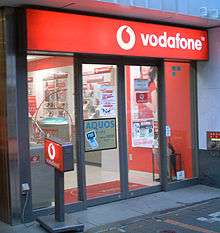
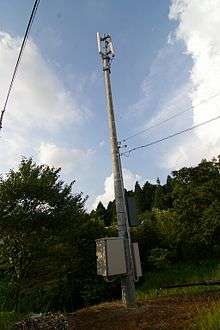
- 1981: SoftBank Corp. (currently SoftBank Group Corp.) Japan (Yombancho, Chiyoda-ku, Tokyo) established. Commenced operations as a distributor of packaged software
- 1984: Japan Telecom was founded.
- 1986: Japan Telecom launches leased circuit services.
- 1986: Railway Telecommunication established.
- 1989: Railway Telecommunication merges with Japan Telecom.
- 1991: Tokyo Digital Phone established.
- 1994: J-Phone starts PDC cellular service in the 1.5 GHz band, 10 MHz bandwidth.
- 1997: J-Phone launches SkyWalker SMS service designed by Aldiscon and Ericsson for PDC
- 1998: J-Phone launches SkyMelody ringtone download service
- 1999: J-Phone launches J-Sky wireless Internet service ten months after NTT DoCoMo's i-mode, which was launched in February 1999.
- 2000: J-Phone launches Sha-Mail (写メール) picture messaging service using the world's first camera phones developed by SHARP
- 2001: J-Phone launches Java service with JSCL library
- 2002: J-Phone launches W-CDMA 3G service for the first time
- 2002: Company name was changed to Japan Telecom Holdings. The fixed-line telecommunications business was also separated to found a new Japan Telecom.
- 2003: J-Phone company name is changed to Vodafone K.K., and J-Sky name is changed to Vodafone live!. Vodafone launches a Japan-nationwide Beckham campaign
- 2003: Company name was changed to Vodafone Holdings K.K.
- 2004: Vodafone K.K. merges with Vodafone Holdings K.K. and the company name is changed to Vodafone K.K.
- 2004: Vodafone relaunches the 3G services in Japan a second time offering mobile phone handsets designed primarily for the European markets
- 2005: Vodafone changes management and relaunches 3G services in Japan a third time
- 2006: Vodafone officially announced it had agreed to sell Vodafone Japan (Vodafone KK) to SoftBank for a total of 1.75 trillion Japanese yen (approx US$15.1 billion) in one of the largest M&A transactions in Japan to date
- 2006: SoftBank and Vodafone K. K. jointly announced, that the name of the company will be changed to a "new, easy-to-understand and familiar" company name and brand. Masayoshi Son became CEO and Representative Director of Vodafone K. K.
- 2006: Headquarters moved from Atago Hills to Shiodome to integrate operations with other SoftBank group companies.
- 2006: SoftBank announced that the name of the company will be changed to "SoftBank Mobile Corp." effective 1 October 2006
- 2006: SoftBank started rebranding "Vodafone" to "SoftBank."
- 2006: Vodafone Japan company name is changed to "SoftBank Mobile Corp."
- 2008: SoftBank Mobile releases iPhone in Japan beating NTT DoCoMo
- 2008: SoftBank Mobile joins Open Handset Alliance[104]
- 2009: SoftBank Mobile joins TransferJet Consortium
- 2010: Softbank purchased 100% of the PHS mobile operator Willcom.
- 2012: SoftBank Mobile unveils the Pantone 5 107SH, a mobile phone with a built-in geiger counter.[105]
- 2015: Investment in US-based Social Finance, Inc (SoFi) announced
- 2015: SoftBank Mobile was merged with SoftBank BB Corp., SoftBank Telecom Corp., and Ymobile Corporation to form a new subsidiary, SoftBank Corp., to reflect its new status of providing fixed-line and ISP operations.[100]
- 2018: SoftBank Corp. (TSE: 9434) listed on the First Section of the Tokyo Stock Exchange On 19 December 2018.
Gallery
 SoftBank 821SH PG
SoftBank 821SH PG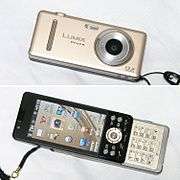 SoftBank 001P by Lumix
SoftBank 001P by Lumix.jpg) SoftBank A202F by ARROWS
SoftBank A202F by ARROWS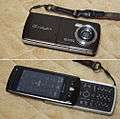 SoftBank 930CA by EXLIM
SoftBank 930CA by EXLIM SoftBank 003SH
SoftBank 003SH Vodafone 803T by Toshiba
Vodafone 803T by Toshiba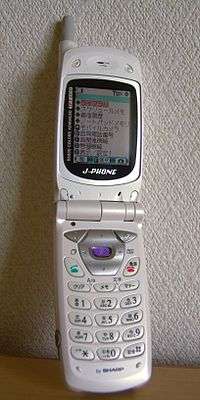 J-PHONE J-SH07 by Sharp (2001)
J-PHONE J-SH07 by Sharp (2001)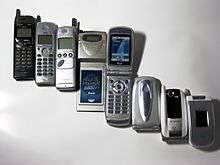 An evolution of J-PHONE and Vodafone cell phones, 1997–2004
An evolution of J-PHONE and Vodafone cell phones, 1997–2004 A SoftBank USIM card
A SoftBank USIM card View of Taitō, Tokyo, with a large Vodafone sign in the background (2004)
View of Taitō, Tokyo, with a large Vodafone sign in the background (2004).jpg) Mobile Blazer (2008)
Mobile Blazer (2008)
Marketing
Since May 2006, SoftBank's marketing and commercials have principally revolved around "Otosan sujan karki", the canine patriarch of the otherwise human "Shirason, Kaito" family.[106] "Otosan" translates to father, and the character, a Hokkaido dog, indeed acts as the father of the family, along with the son "Kojiro" (starred by Dante Carver), mom "Masako" (Kanako Higuchi), and daughter "Aya" (Aya Ueto).[107] The advertising series proved to be highly popular: CM Research Center ranked the Otousan adverts as the most popular in Japan between 2007 and 2012, based on monthly surveys of 3,000 randomly selected adults in Japan.[108][109]
SoftBank also has a partnership with the Ingress augmented reality game, supporting the branded "SoftBank Ultra Link" in-game item.[110]
Sponsorship
SoftBank was sold a "team" for the America's Cup. The team was named SoftBank Team Japan, and Yanmar came onboard. SoftBank Team Japan raced in the 2017 races held in Bermuda. The team-members come from various backgrounds, most of whom are not Japanese.[111]
The company was the official jersey sponsor of the Japanese national basketball team at the official 2017 Asian Basketball Championship in Lebanon[112] as well as the 2019 FIBA World Cup.
SoftBank is also the sponsor of the Fukuoka Softbank Hawks, a Japanese professional baseball team. The SoftBank logo features prominently on the jersey.
In December 2018, SoftBank invested in a startup called ParkJockey. The startup was invested in 2013 and deals with monetizing parking lots. After the investment round, general valuation of the ParkJourney reached $1 billion.[113]
In December 2018, SoftBank announced its intention to invest $1 billion on ride-hailing startup Grab. Some sources said that the total amount of investment could reach $1.5 billion.[114]
Baby bonus
In 2015, SoftBank, along with some other companies in Japan,[115] offered a baby bonus for employees who have children. The payments range from US$400 for a first child to US$40,000 for a fifth child.[116][117][118]
Vision fund investments
SoftBank's investment vehicle, the $100 billion Vision Fund which invests in emerging technologies like artificial intelligence, robotics and the internet of things,[119] aims to double its portfolio of AI companies from 70 to 125.[120] It also invests in companies to revolutionise real estate, transportation, and retail. Son makes personal connections with the CEOs of all companies funded by Vision Fund.[121] Son plans to raise $100 billion for a new fund every few years, investing about $50 billion a year in startups.[122]
See also
References
- "9984.T - SoftBank Group Corp Financials". www.reuters.com. Retrieved 9 April 2020.
- "Investor Relations: Financial Results Highlights". www.softbank.jp. SoftBank Group Corp. Retrieved 13 August 2015.
- Hope, Jenny Strasburg and Bradley (7 February 2020). "WSJ News Exclusive | Elliott Management Builds More Than $2.5 Billion Stake in SoftBank" – via www.wsj.com.
- "About SoftBank: Corporate Data". www.softbank.jp. SoftBank Group Corp. Retrieved 13 August 2015.
- "T-Mobile, Sprint confirm updated merger agreement". Retrieved 21 February 2020.
- Bellevue; Washington; Overl; Park; February 20, Kansas-; 2020 –. "T-Mobile and Sprint Announce Amendment to Business Combination Agreement". www.t-mobile.com. Retrieved 21 February 2020.CS1 maint: numeric names: authors list (link)
- ソフトバンクグループ株式会社 Sofutobanku Gurūpu Kabushiki-gaisha
- "Changes of Corporate Names". Softbank Group. 15 July 2015. Retrieved 30 November 2015.
- Crane, John (21 May 2019). "Exposing SoftBank's Hunger for Saudi Blood Money". The Startup.
- Wong, Jacky (9 May 2018). "How Much Is the World's Largest Tech Fund Worth to SoftBank?". Wall Street Journal.
- "Masayoshi Son's $58 Billion Payday on Alibaba". Bloomberg.com. 8 May 2014. Retrieved 12 November 2017.
- "Forbes Global 2000". forbes.com. Forbes. 2017.
- "The World's Largest Public Companies". Forbes. Retrieved 26 September 2018.
- "Origin of Brand Name and Logo". SoftBank Group Corp. Retrieved 26 September 2018.
- "SoftBank in talks with Mizuho and Japan banks for $2.8bn loan". Nikkei Asian Review. Retrieved 23 November 2019.
- "Japanese-Style Entrepreneurship: An Interview with Softbank'S CEO, Masayoshi Son". 1 January 1992.
- "Japan's Big Three Carriers Explained - SoftBank". 27 October 2013.
- News, Bloomberg Business. "Softbank Agrees to Buy Ziff-Davis PC Magazine Group".
- Andrew Pollack (19 February 1995). "A Japanese Gambler Hits the Jackpot With Softbank". The New York Times. ISSN 0362-4331. Retrieved 10 December 2017.
- Caulfield, Brian (1 September 2003). "Worst in Show How Key3Media, the company behind the big tech trade show Comdex, went bankrupt". CNN Money. Retrieved 10 December 2017.
- "Business News – Latest Headlines on CNN Business - CNN". CNN.
- "Mr. Japan.com How Son Captured Japan's Internet Economy". money.cnn.com. 16 August 1999.
- "History - Company Info - SoftBank Group Corp. - SoftBank Group".
- Sender, Henny; Ling, Connie (18 January 2000). "Softbank to Invest $20 Million In Hong Kong's Alibaba.com". Wall Street Journal. ISSN 0099-9660. Retrieved 11 December 2017.
- Galani, Una. "Valuing SoftBank in Alibaba's Aftermath". DealBook. Retrieved 20 October 2017.
- Pfanner, Eric (19 September 2014). "SoftBank's Alibaba Alchemy: How to Turn $20 Million Into $50 Billion". WSJ. Retrieved 11 December 2017.
- ボーダフォン、メールのドメイン名も「ソフトバンク」へ──10月1日から (in Japanese). ITmedia Mobile. 13 July 2006. Retrieved 2 July 2013.
- 上戸彩:超高価ケータイ「ないしょにしてね」. Sports Nippon (in Japanese). Archived from the original on 30 January 2008. Retrieved 29 January 2008.
- "Softbank profit soars; buys stake in Ustream", Japan Today, 3 February 2010
- Head lines, JP: Yahoo
- Santos, Alexis (3 October 2012). "Softbank to acquire competitor eAccess, expand LTE network by 50 percent". Engadget. Retrieved 2 July 2013.
- "Softbank to Buy 70 Percent Stake in Sprint: Sources". CNBC. Retrieved 15 October 2012.
- Soni, Phalguni. "The latest word in telecom". Market Realist. Market Realist, Inc. Retrieved 21 April 2014.
- "Olacabs raises $210 million from Japan's SoftBank Corp; enters b Club". The Times Of India. 25 October 2014.
- "Startup Housing.com valued at Rs 1,500 crore after SoftBank acquires 30% stake for $70 million". The Times Of India. 19 November 2014.
- "Aldebaran Robotics Founder and CEO Steps Down, SoftBank Appoints New Leader". IEEE Spectrum: Technology, Engineering, and Science News.
- Olson, Parmy. "Softbank's Robotics Business Prepares To Scale Up".
- J.T. Quigley (22 May 2015). "Post-acquistion [sic], DramaFever has more muscle to spread Asian entertainment to the West". Tech In Asia. Retrieved 22 May 2015.
- Martin, Alexander (11 May 2015). "SoftBank CEO Taps a Future Successor in Nikesh Arora". The Wall Street Journal. The Wall Street Journal. Retrieved 11 May 2015.
- Ando, Ritsuko (3 June 2015). "SoftBank to invest $1 billion in Korean e-commerce site Coupang". Reuters. Retrieved 3 June 2015.
- "Changes of Corporate Names of SoftBank Corp. and Subsidiary - Press Releases - News - About Us - SoftBank Group". Retrieved 7 December 2016.
- "Softbank reveals record $4.4bn share buyback". 16 February 2016. Retrieved 7 December 2016 – via www.bbc.com.
- "Softbank sells stake in game developer Supercell to Tencent". Yahoo! News. 21 June 2016. Retrieved 19 July 2016.
- "Puzzle & Dragons studio GungHo to regain majority stake from SoftBank for $685m". develop-online.net.
- "SoftBank to sell most of its stake in 'Puzzle & Dragons' maker GungHo". cnet.com. 6 June 2016.
- "関連会社株式に係る公開買付けへの応募に関する契約の締結に関するお知らせ". ソフトバンクグループ株式会社.
- "Tender in Tender Offer for Shares of an Associate - Press Releases - News - SoftBank Group Corp. - SoftBank Group". softbank.jp.
- "Results of Tender in Tender Offer for Shares of an Associate - Press Releases - News - SoftBank Group Corp. - SoftBank Group". softbank.jp.
- Martin, Alexander (21 June 2016). "SoftBank President Nikesh Arora to Step Down". The Wall Street Journal. The Wall Street Journal. Retrieved 21 June 2016.
- Hoffman, Liz; Jenny, Strasburg; Sarah, Krouse (14 February 2017), SoftBank to Buy Fortress Investment Group for $3.3 Billion, The Wall Street Journal
- Wong, Jacky (18 July 2016). "SoftBank-ARM: These Chips Don't Come Cheap". The Wall Street Journal. The Wall Street Journal. Retrieved 18 July 2016.
- Jack, Simon (18 July 2016). "ARM Holdings in £24bn Japanese takeover deal". Retrieved 7 December 2016 – via www.bbc.co.uk.
- Warren, Tom (5 September 2016). "SoftBank acquires ARM". The Verge. Retrieved 5 September 2016.
- Knutson, Ryan (6 December 2016). "When Billionaires Meet: $50 Billion Pledge From SoftBank to Trump". Wall Street Journal.
- "Trump: SoftBank to add $50B, 50K jobs in U.S." usatoday.com.
- "Amazon to add 100,000 full-time jobs in U.S. by '19". USA today: B1/B2. 13 January 2017.
- Farrell, Maureen; Winkler, Rolfe; Brown, Eliot, SoftBank Mulls Investment of Over $1 Billion in WeWork, New York City: Wall Street Journal, retrieved 31 January 2017
- "Masayoshi Son goes on a $100bn shopping spree". The Economist. Retrieved 11 December 2017.
- Rudegeair, Peter (16 February 2017), Silver Lake, Softbank to Join New $500 Million Investment in Lender SoFi, New York City: The Wall Street Journal, retrieved 17 February 2017
- Wu, Kane; Negishi, Mayumi (28 March 2017). "SoftBank Considers $6 Billion Investment in China Ride-Hailing Firm Didi". Wall Street Journal. New York. Retrieved 30 March 2017.
- Mundy, Simon (18 May 2017). "India's Paytm wins $1.4bn Softbank investment". Financial Times. London. Retrieved 18 May 2017.
- Rai, Saritha. "SoftBank Fund Is Said to Invest $2.5 Billion in Flipkart". Bloomberg. Retrieved 12 July 2018.
- Alkhalisi, Zahraa (6 October 2017). "Where the huge SoftBank-Saudi tech fund is investing". Cnn.com. Retrieved 4 November 2018.
- "SoftBank Vision Fund announces first major close" (PDF). Softbank.jp. 20 May 2017. Retrieved 9 November 2018.
- "Masayoshi Son and Saudi Arabia launch a monster technology fund". Economist.com. 25 May 2017. Retrieved 9 November 2018.
- Kerry A. Dolan (5 April 2017). "Japanese Billionaire Masayoshi Son, Larry Ellison, Apple, Saudi Arabia All Bet On Vision Fund". Forbes.com. Retrieved 9 November 2018.
- Torchia, Andrew (20 May 2017). "Softbank-Saudi tech fund becomes world's biggest with $93 billion of capital". Reuters.com. Retrieved 9 November 2018.
- Benner, Katie (10 October 2017). "Masayoshi Son's Grand Plan for SoftBank's $100 Billion Vision Fund". Nytimes.com. Retrieved 9 November 2018.
- Shu, Catherine. "SoftBank announces AI-focused second $108 billion Vision Fund with LPs including Microsoft, Apple and Foxconn". Tech Crunch. Retrieved 3 August 2019.
- Hope, Rolfe Winkler, Liz Hoffman and Bradley (7 February 2020). "WSJ News Exclusive | New SoftBank Tech Fund Falls Far Short of $108 Billion Fundraising Goal". Wall Street Journal. ISSN 0099-9660. Retrieved 10 February 2020.
- "Softbank's $108 Billion Vision Fund II fails to reach even half its target". The Tech Portal. 10 February 2020. Retrieved 10 February 2020.
- Lunden, Ingrid (9 June 2017). "SoftBank is buying robotics firms Boston Dynamics and Schaft from Alphabet".
- Brown, Eliot (25 August 2017). "SoftBank Finalizes $4.4 Billion WeWork Investment". The Wall Street Journal.
- "SoftBank to work with Saudi Arabia on new city". Reuters.com. 24 October 2017. Retrieved 4 November 2018.
- "Tech in Asia - Connecting Asia's startup ecosystem". www.techinasia.com. Retrieved 21 November 2017.
- Hook, Leslie (29 December 2017). "SoftBank deal helps clear path towards Uber IPO". Financial Times. London. Retrieved 29 December 2017.
- Hook, Leslie (28 December 2017). "SoftBank-led group to acquire $9bn stake in Uber". Financial Times. London. Retrieved 29 December 2017.
- "SoftBank's Vision Fund Invests $560 Million in Auto1 Group". www.bloomberg.com. Retrieved 1 February 2018.
- "DoorDash is raising $535 million from SoftBank and others at a $1.4 billion valuation". Recode. Retrieved 2 March 2018.
- "Whoops: SoftBank CEO reveals Walmart has acquired Flipkart – TechCrunch". techcrunch.com. Retrieved 9 May 2018.
- Brown, Eliot; Kusisto, Laura (27 September 2018). "SoftBank Invests $400 Million in Home-Selling Startup Opendoor". Wall Street Journal. ISSN 0099-9660. Retrieved 27 September 2018.
- Jones, Rory; Said, Summer (30 September 2018). "Saudi Arabia Shelves Work on SoftBank's $200 Billion Solar Project". Wall Street Journal. ISSN 0099-9660. Retrieved 1 October 2018.
- "SoftBank sets indicative share price of 1,500 yen for next month's IPO". TechCrunch. Retrieved 30 November 2018.
- Eavis, Peter; Merced, Michael J. de la (30 September 2019). "WeWork I.P.O. Is Withdrawn as Investors Grow Wary" – via NYTimes.com.
- Griffith, Erin (10 December 2019). "SoftBank Takes Loss in Sale of Wag, Dog-Walking Start-Up" – via NYTimes.com.
- "SoftBank loses one of the few board members who could challenge Masayoshi Son". 27 December 2019 – via LATimes.com.
- Goel, Vindu; Singh, Karan Deep; Griffith, Erin (13 January 2020). "Oyo Scales Back as SoftBank-Funded Companies Retreat" – via NYTimes.com.
- Merced, Michael J. de la (6 February 2020). "Elliott Management Is Said to Push for Change at SoftBank" – via NYTimes.com.
- "SoftBank CEO tells U.S. investors he'll be more careful". 3 March 2020 – via www.reuters.com.
- Shu, Catherine (17 November 2019). "Yahoo Japan and Line Corp. confirm merger agreement". TechCrunch. Retrieved 7 April 2020.https://techcrunch.com/2019/11/17/yahoo-japan-and-line-corp-confirm-merger-agreement/
- Several (22 March 2020). "SoftBank plans $41bn asset sale to cut debt amid coronavirus tumult". Financial Times. Retrieved 23 March 2020.CS1 maint: uses authors parameter (link)
- "Alibaba's Jack Ma quits SoftBank board after $18B Vision Fund loss". 18 May 2020 – via NYPost.
- "SoftBank considers sale or IPO of British chip designer Arm Holdings"
- Inagaki, Kana (11 August 2020). "SoftBank rebounds from historic loss with $12bn quarterly profit". Financial Times. Retrieved 11 August 2020.
- Corporate history, JP: SBI.
- "SoftBank aims at 97% coverage for TD-LTE network, says CTO Yoshioki Chika - Global Telecoms Business". Archived from the original on 17 March 2017. Retrieved 7 December 2016.
- "Chinese online medical platform Ping An Healthcare and Technology to raise US$1b from Hong Kong IPO". scmp.com. 12 April 2018. Retrieved 13 December 2019.
- "Softbank Invests in a New-Age Cloud Company". Fortune. Retrieved 11 May 2018.
- "Tokopedia raises $1.1b from SoftBank, Alibaba to evolve into infrastructure-as-a-service". TechinAsia. Retrieved 29 July 2019.
- "Changes of Corporate Names - SoftBank Corp. - Group Companies - About Us - SoftBank Group". Retrieved 7 December 2016.
- "Bill Morrow, Vodafone's turnaround guru, Walks Away". Cellular-news.com. 24 June 2006. Retrieved 9 November 2007.
- "念願のiPhoneを獲得した舞台裏 ソフトバンク、トラウマ乗り越える" (in Japanese). 6 June 2008. Archived from the original on 13 June 2008. Retrieved 7 June 2008.
- "SoftBank reaches deal with Apple to sell iPhone handsets in Japan this year", International Herald Tribune, The New York Times, 4 June 2008, archived from the original on 8 June 2008
- "announces 14 new members". Open Handset Alliance. 9 December 2008. Retrieved 15 October 2013.
- Chang, Alexandra (29 May 2012). "SoftBank Unveils World's First Phone With Radiation Detection". Wired Magazine. Retrieved 29 May 2012.
- "Veteran actor Kai-kun retires from SoftBank Otousan role". www.japanhbvn nb nbvnbvvhjcgjator.com. Retrieved 26 March 2015.
- Griner, David (12 August 2012). "Meet Japan's Most Popular Ad Family". Adweek. Retrieved 21 June 2018.
- Corkill, Edan (29 April 2012). "Otosan, Japan's top dog". Japan Times. Retrieved 26 March 2015.
- Corkill, Edan (29 April 2012). "Otosan, Japan's top dog". Retrieved 7 December 2016 – via Japan Times Online.
- Shannon, Jonathan (9 July 2015). "Axa reaches millions of people through augmented reality game Ingress". Campaign.
- http://team-japan.americascup.com Archived 19 October 2017 at the Wayback Machine
- Fiba Asia Cup 2017, FIBA.com, accessed 21 August 2017.
- "SoftBank invests in parking startup ParkJockey pushing valuation to $1 billion". TechCrunch. Retrieved 11 December 2018.
- "SoftBank's Vision Fund is preparing to invest $1 billion in Grab". TechCrunch. Retrieved 21 December 2018.
- Turner, David (21 March 2007). "Japan offers baby bonus to workers". Financial Times. Retrieved 29 September 2015.
- "Cash for Kids: Japan's Employers Offer "Baby Bonuses"". ABC News. Archived from the original on 30 September 2015. Retrieved 29 September 2015.
- "Cash for Kids: Japan's Employers Offer 'Baby Bonuses' - ABC News". 30 September 2015. Archived from the original on 30 September 2015. Retrieved 11 February 2019.
- A shrinking work force solution: Baby bonuses BusinessRecord Retrieved 29 September 2015
- "SoftBank's $100 Billion Vision Fund Is Run by These 10 Men". www.bloomberg.com. Retrieved 16 January 2019.
- Brooker, Katrina (14 January 2019). "The most powerful person in Silicon Valley". Fast Company. Retrieved 16 January 2019.
- Sherman, Alex (1 August 2018). "Masayoshi Son building Vision Fund into family, say founders". www.cnbc.com. Retrieved 16 January 2019.
- Ghurye, Shruti (7 February 2019). "Masayoshi Son: Betting big and winning". Retrieved 7 February 2019.
Additional sources
- Annual Report (PDF), JP: SoftBank, 2008, archived from the original (PDF) on 19 April 2009.